
Tehran has come to terms with six world powers on redesigning the Arak heavy-water reactor in central Iran to make it incapable of producing plutonium suitable for a nuclear weapon.
The foreign ministers of all seven countries involved in agreeing to the Joint Comprehensive Plan of Action (JCPOA) on July 14 signed the document outlining the redesign of the Arak reactors over the past two weeks. Also signing was Federica Mogherini, the European Union’s foreign policy representative.
The document was signed by the various parties on three separate days – Nov. 13, 17 and 18 – and became effective the day it received the final signature. Iran’s Islamic Republic News Agency (IRNA) announced that the process was complete on Saturday.
The status of the reactor was a major stumbling block during the negotiations between Iran and the five permanent member of the United Nations Security Council – Britain, China, France, Russia and the United States – as well as Germany, a group known as the P5+1.
But all the parties finally agreed that work must begin to remove the core of the 40-megawatt reactor to prevent it from producing weapons-grade plutonium before the P5+1 could agree to lift the sanctions that served as an incentive for Iran to agree to limits on its nuclear program.
According to the document, “China will participate in the redesign and the construction of the modernized reactor,” and Washington “will provide technical support and review of the modernized reactor design.” Britain, France and Germany will review the work, Russia will offer “consultative service,” and Mogherini will coordinate the approval process of designs and equipment.
“The primary design of Arak reactor will take one year,” Iranian state broadcaster IRIB on Saturday quoted Behrouz Kamalvandi, a spokesman for the Atomic Energy Organization of Iran (AEOI), as saying. “Then the [P5+1] working group has three months to approve it.”
Ali Akbar Salehi, the director of the AEOI, welcomed the ratification of the document. “Now, the path to implement the JCPOA has been paved,” he said Thursday. Salehi, himself a nuclear physicist, said that under the July agreement, Iran will allow the U.N.’s nuclear monitor, the International Atomic Energy Agency, to inspect the capabilities of his country’s nuclear facilities to determine their suitability for making weapons, a condition known as the “possible military dimension” (PMD) of these plants.
Iran said Friday that the IAEA’s report on the PMD will be issued in early December, a move that will put the JCPOA into effect. Salehi cautioned that the PMD question must be resolved by mid-December as a condition for Iran to allow the redesign of the Arak reactor.
Throughout the negotiations that led to the nuclear agreement, Iran denied that its nuclear program was designed to create a nuclear weapon. Instead, the government insisted that it was designed to generate energy and to produce isotopes to treat diseases such as cancer.
This article originally appeared on Oilprice.com
More Must-Reads From TIME
- The 100 Most Influential People of 2024
- Coco Gauff Is Playing for Herself Now
- Scenes From Pro-Palestinian Encampments Across U.S. Universities
- 6 Compliments That Land Every Time
- If You're Dating Right Now , You're Brave: Column
- The AI That Could Heal a Divided Internet
- Fallout Is a Brilliant Model for the Future of Video Game Adaptations
- Want Weekly Recs on What to Watch, Read, and More? Sign Up for Worth Your Time
Contact us at letters@time.com